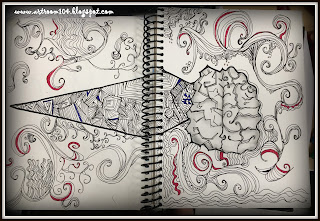I use the zentangle unit as a confidence booster. My Studio Art classes are primarily filled with students who HAVE to be there for the credit to get the Regents Diploma. Aside from the few music students who ask to take my Studio Art classes, most of them think they have no artistic ability, nor do they really want to be there. I'm happy to say that I'm already changing some of their minds about art!
Anyways, we begin the unit by looking at Kerby Rosanes and his doodle art. We talk about how he turned something he enjoyed doing as a hobby into his job, how his creative process works, and how he organizes his artwork. I use this unit as a way to review the elements and principles of art and to talk about composition. Then, the students learn about zentangling. I have tons of books about zentangling, as well as daily brain activity cards that teach a new zentangle pattern, step-by-step. They really enjoyed using those cards. These are a few of the zentangle tiles the students completed at the beginning of the unit. (Mind you, at this point we have not dove into value, so anything you see here is what they remember from 7th grade.)
Next came the actual unit project. In my effort to be more choice based this year, students were allowed to incorporate anything into their design that they wanted. I encouraged them to send a message with their work or to use a subject that interested them. Most of the time I hit resistance here because they don't know how to concentrate their ideas into something doable, but I think the open-ended visual journals that we started the year off jump-started their noggins, because every student managed to come up with a great idea!
I also mentioned that it caused a bit of a debate. In past years, students embraced the zentangle name because it was an interesting word and many of them were very literal, enjoying the step-by-step process behind zentangles. This year, I had quite a few challenge me. "Why do we have to follow steps? Can't we just draw?" "Seriously, I already do this kind of stuff in my notebook, see Mrs. Impey..."
And this, of course, led to discussions about marketing, branding, what makes something art, and so on! It was great! Aside from having an obvious subject and focal point in this work, I did require them to use patterns in a way to enhance their work, whether they called them zentangles or not, because it forced them to think about composition and those principles of art. I didn't push the use of the zentangle cards or books (except for bell ringers, which I'll share in my next post), to get the artistic juices flowing.
She comes from a farming family. ;)
Sarge and Tahlia are his family's dogs.
This one and the next come from a couple of gamers.
This student incorporated some of her own poetry!
And this one is very religious.
She incorporated the first letter of her first name.
The one of the left came from a sports student, and on the right, another gamer.
Coming next will be a post about our bell ringers!



























